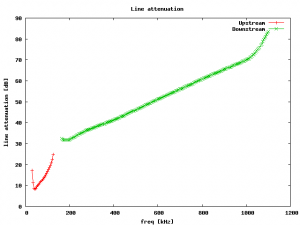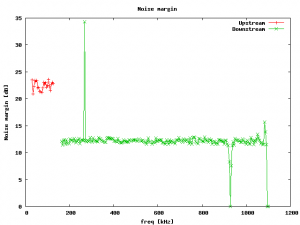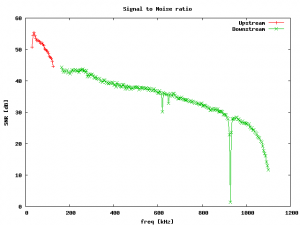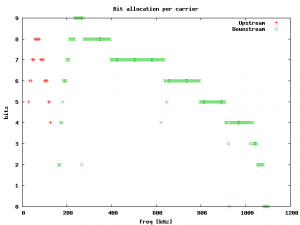When studying for my Cisco ISCW exam, I wanted to get somewhat more in-depth information on the different DSL-techniques.
First of all, there are different DSL techniques, ranging from IDSL (providing 144/144kbps) over the popular ADSL (somewhere around 1/10Mbps up/down) up to the newer VDSL variants (around 50Mbps). Within each technique, there are different modulation schemes.
I decided to explore what my Alcatel SpeedTouch modem (now Thomson) had to tell me; here is the report.
My Alcatel Speedtouch is manageble via regular telnet. Just pressing enter at the “User :” prompt gets you into the console. The things you can do and see are rather limited, until you go into some kind of “debug” mode:
=>td prompt ========================DISCLAIMER========================= Access to expert mode is intended for qualified personnel only. Press ENTER to return to user mode. =====================END=OF=DISCLAIMER===================== 'SpeedTouch (00-90-D0-xx-xx-xx)' Password : ********** Switched to 'Trace & Debug' prompt. Return to Normal mode by typing >
The password is the decimal representation of the CRC value of the ‘SpeedTouch (00-90-D0-xx-xx-xx)’ string (excluding the quotes). The CRC is of order 32, uses polynomial 0x5C22DB93, direct, non-reversed bytes and has both an initial and a final XOR with 0xFFFFFFFF. This page has a generic CRC calculator in JavaScript you can use to get your password, or you can use the Digest::CRC perl module like this.
Once in the debug mode, a lot more commands are available:
>help Following topics are available : dbg err xapi guard rip ni etha atm atm eth llc atmf iwu sock ipoa ipoa tcp pptp config system softwa phoneb adsl nat cip ppp bridge dns dhcp dhcpc tftp sachem eoc aoc hs mlit msit golden tdsl >
By just looking around, I found the following useful information:
>sachem sachem>get_opmode Lite mode is not set DMT mode is set sachem>
Which indicates that the used modulation is G.922.1
Since the modem only sees one end of the line, it can only tell about half of the line parameters; unless you activate “golden mode”:
>tdsl tdsl>help Following commands are available for ADSL ANT : lineState leds ripData customConfig staticConfig powerConfig vendor shutdownCond Test facilities: activate deactivate restAccept restart tuneUSPowerCutBack <0-64> setOperModeallowedOperMode setPermissions permissions golden potsTest tdsl>golden on tdsl>
This will cause the DSL-line to re-sync, but will show the parameters from the DSLAM-end as well:
>golden
golden>help
Golden debug commands
---------------------
{} mandatory, [] optional parameters.
modem_variant : Get the modem golden start state.
modem_state : Get the modem state.
configuration : Get the configuration data.
identification : Get the identification data.
common_settings : Get the common settings data.
operational_data [init] : Get the operational data.
channel_data : Get the channel data.
operational_channel [init] : Get the operational channel data.
carrier_data [init] : Get the carrier data.
initialization_error : Get the initialization error.
start_traffic : Start traffic measurement.
stop_traffic : Stop traffic measurement.
endian_stream : Toggle endian mode of the golden streaming mode.
golden>modem_variant
The modem is POTS G.DMT.
Receive channel first carrier = 38
Receive channel last carrier = 255
Tramsmit channel first carrier = 7
Transmit channel last carrier = 29
golden>modem_state
The modem is in SHOWTIME_L0.
golden>configuration
Configuration report
--------------------
ATUC
====
Minimum noise margin downstream : 0
Minimum noise margin upstream : 0
Max. additional noise margin downstream : 31
Max. additional noise margin upstream : 31
Target noise margin downstream : 6
Target noise margin upstream : 6
Max. PSD downstream : -40
Rate adaptivity mode downstream : 2
Rate adaptivity mode upstream : 2
Interleaf min bit rate downstream : 0
Interleaf min bit rate upstream : 0
Interleaf planned bit rate downstream : 0
Interleaf planned bit rate upstream : 0
Interleaf max bit rate downstream : 0
Interleaf max bit rate upstream : 0
Interleaf max delay downstream : 16
Interleaf max delay upstream : 16
Fast min bit rate downstream : 288
Fast min bit rate upstream : 96
Fast planned bit rate downstream : 4640
Fast planned bit rate upstream : 512
Fast max bit rate downstream : 4640
Fast max bit rate upstream : 512
Carrier Mask (x=masked, o is not masked)
Carrier 0 : o o o o o o o o o o
Carrier 10 : o o o o o o o o o o
Carrier 20 : o o o o o o o o o o
Carrier 30 : o o o o o o o o o o
Carrier 40 : o o o o o o o o o o
Carrier 50 : o o o o o o o o o o
Carrier 60 : o o o o o o o o o o
Carrier 70 : o o o o o o o o o o
Carrier 80 : o o o o o o o o o o
Carrier 90 : o o o o o o o o o o
Carrier 100 : o o o o o o o o o o
Carrier 110 : o o o o o o o o o o
Carrier 120 : o o o o o o o o o o
Carrier 130 : o o o o o o o o o o
Carrier 140 : o o o o o o o o o o
Carrier 150 : o o o o o o o o o o
Carrier 160 : o o o o o o o o o o
Carrier 170 : o o o o o o o o o o
Carrier 180 : o o o o o o o o o o
Carrier 190 : o o o o o o o o o o
Carrier 200 : o o o o o o o o o o
Carrier 210 : o o o o o o o o o o
Carrier 220 : o o o o o o o o o o
Carrier 230 : o o o o o o o o o o
Carrier 240 : o o o o o o o o o o
Carrier 250 : o o o o o o
Near end M3 configurationData
=============================
US power cutback : 0
Near end POTS overlay Operation modes : 11
Near end POTS overlay permissions 0 : 12353
Near end POTS overlay permissions 1 : 12359
Near end POTS overlay permissions 2 : 12288
Near end POTS overlay permissions 3 : 12377
Near end POTS overlay permissions 4 : 4096
Near end POTS overlay permissions 5 : 4096
Near end POTS overlay permissions 6 : 4096
Near end POTS overlay permissions 7 : 4096
Near end ISDN overlay Operation modes : 0
Near end ISDN overlay permissions 0 : 0
Near end ISDN overlay permissions 1 : 0
Near end ISDN overlay permissions 2 : 0
Near end ISDN overlay permissions 3 : 0
Near end ISDN overlay permissions 4 : 0
Near end ISDN overlay permissions 5 : 0
Near end ISDN overlay permissions 6 : 0
Near end ISDN overlay permissions 7 : 0
golden>identification
only available in ANSI-mode, use M3Identification !
Identification report : near end
----------------------------------
VendorId : 0xffffffff
VersionNumber : 0xffffffff
Identification report : far end
---------------------------------
VendorId : 0xffffffff
VersionNumber : 0xffffffff
golden>common_settings
Common settings report : near end
---------------------------------
Trellis coding : active
Echo cancelling : not active
Framing mode : Minimum Overhead Framing
Maximum number supported Tx bits per carrier : 13
Common settings report : far end
---------------------------------
Trellis coding : active
Echo cancelling : not active
Framing mode : Minimum Overhead Framing
Maximum number supported Tx bits per carrier : 14
golden>operational_data
Operational data report : near end (Downstream)
-----------------------------------------------
Attainable line rate : 6684 kbit/sec
Attainable Atm rate : 6208 kbit/sec
Used line rate : 5112 kbit/sec
Fast used Atm rate : 4640 kbit/sec
Interleaved used Atm rate : 0 kbits/sec
Rel. capacity occupation : 76
Noise Margin : 8 dB
Line attenuation : 39 dB
Output Power : 19 dBm
Operational data report : far end (Upstream)
--------------------------------------------
Attainable line rate : 1112 kbit/sec
Attainable Atm rate : 992 kbit/sec
Used line rate : 608 kbit/sec
Fast used Atm rate : 512 kbit/sec
Interleaved used Atm rate : 0 kbits/sec
Rel. capacity occupation : 55
Noise Margin : 21 dB
Line attenuation : 17 dB
Output Power : 12 dBm
golden>channel_data
Channel report : near end (Downstream)
--------------------------------------
1) SNR (dB)
Carrier 38 : 44.4 43.5
Carrier 40 : 42.9 43.4 42.9 43.1 43.4 42.5 42.9 42.3 42.9 43.4
Carrier 50 : 43.4 43.1 43.6 43.3 43.2 43.3 42.7 43.4 43.5 43.6
Carrier 60 : 43.8 43.2 43.3 42.7 43.3 41.4 42.1 41.4 42.1 41.9
Carrier 70 : 42.1 41.6 41.1 40.9 41.3 40.8 40.8 40.4 40.7 39.9
Carrier 80 : 40.2 39.6 40.3 40.1 39.6 39.2 39.5 39.1 39.6 39.2
Carrier 90 : 39.2 39.6 39.4 38.6 38.8 38.1 39.4 38.7 38.4 38.8
Carrier 100 : 38.2 38.1 38.8 38.8 38.1 37.4 38.3 37.4 38.2 38.1
Carrier 110 : 37.9 37.3 37.8 37.6 37.9 38.1 37.9 38.0 37.9 37.2
Carrier 120 : 37.5 37.9 37.7 37.8 37.7 37.4 37.6 37.8 37.5 37.0
Carrier 130 : 37.6 37.5 37.1 36.9 37.0 37.4 36.9 36.9 36.6 36.1
Carrier 140 : 36.1 36.8 36.3 36.0 30.1 36.3 35.9 35.8 35.6 35.6
Carrier 150 : 32.9 35.3 35.9 35.6 35.1 35.9 35.9 35.4 34.9 34.8
Carrier 160 : 34.3 34.4 34.5 34.5 34.8 34.3 34.0 34.1 33.9 33.9
Carrier 170 : 34.1 33.8 33.4 33.4 33.7 33.3 33.5 33.1 32.9 33.1
Carrier 180 : 32.9 32.9 32.6 32.4 32.9 32.8 31.9 32.1 32.3 32.1
Carrier 190 : 31.6 31.6 31.4 31.3 30.6 30.8 31.1 30.9 31.2 30.6
Carrier 200 : 31.0 30.6 31.1 30.2 30.1 30.3 30.3 30.1 29.3 29.3
Carrier 210 : 29.3 29.1 28.2 27.9 22.9 1.3 23.6 27.9 27.9 28.0
Carrier 220 : 27.8 28.3 28.4 27.7 27.8 27.3 26.8 26.6 27.1 26.6
Carrier 230 : 26.6 26.6 26.4 26.2 26.0 26.2 25.2 24.8 25.0 24.4
Carrier 240 : 24.4 23.8 23.4 23.1 22.2 22.0 21.8 20.8 20.4 19.2
Carrier 250 : 17.7 16.8 16.1 14.2 13.0 11.6
2) Line Attenuation (db)
Carrier 38 : 32.4 32.0
Carrier 40 : 31.8 31.7 31.7 31.7 31.7 31.7 31.8 32.0 32.4 32.7
Carrier 50 : 32.9 33.2 33.4 33.7 34.0 34.3 34.7 34.8 35.0 35.2
Carrier 60 : 35.4 35.7 35.9 36.2 36.4 36.4 36.7 36.8 37.0 37.2
Carrier 70 : 37.3 37.5 37.7 37.8 38.0 38.2 38.4 38.7 38.7 38.9
Carrier 80 : 39.2 39.4 39.4 39.5 39.8 40.0 40.2 40.3 40.5 40.7
Carrier 90 : 40.8 41.0 41.2 41.4 41.7 41.9 41.9 42.2 42.4 42.6
Carrier 100 : 42.9 43.0 43.2 43.3 43.5 43.9 44.1 44.3 44.5 44.7
Carrier 110 : 45.0 45.2 45.5 45.6 45.7 46.0 46.2 46.3 46.7 46.9
Carrier 120 : 47.1 47.3 47.5 47.7 48.0 48.2 48.5 48.6 48.9 49.0
Carrier 130 : 49.2 49.3 49.7 49.9 50.1 50.3 50.5 50.7 51.0 51.2
Carrier 140 : 51.5 51.6 51.7 52.0 52.2 52.3 52.7 52.9 53.1 53.3
Carrier 150 : 53.5 53.7 54.0 54.2 54.5 54.5 54.7 54.9 55.2 55.3
Carrier 160 : 55.5 55.7 56.1 56.1 56.3 56.5 56.7 57.0 57.2 57.5
Carrier 170 : 57.6 57.7 57.9 58.2 58.3 58.5 58.7 59.1 59.3 59.5
Carrier 180 : 59.7 60.0 60.2 60.5 60.5 60.8 61.0 61.3 61.4 61.6
Carrier 190 : 61.8 62.0 62.2 62.3 62.5 62.8 63.0 63.3 63.3 63.5
Carrier 200 : 63.7 63.8 64.0 64.3 64.4 64.6 64.8 65.2 65.3 65.5
Carrier 210 : 65.5 65.8 66.3 66.3 66.5 66.5 66.8 67.1 67.3 67.4
Carrier 220 : 67.8 67.8 68.0 68.2 68.3 68.5 68.8 69.0 69.3 69.5
Carrier 230 : 69.5 69.8 70.0 70.4 70.6 70.6 71.2 71.5 71.8 72.5
Carrier 240 : 72.5 73.3 73.8 74.3 75.0 75.5 75.8 77.0 77.5 78.7
Carrier 250 : 79.8 80.4 81.1 82.2 82.8 83.6
Channel report : far end (Upstream)
-----------------------------------
1) SNR (dB)
Carrier 7 : 50.7 54.5 55.3
Carrier 10 : 54.5 53.6 52.9 52.8 52.8 52.5 52.0 52.1 51.7 51.2
Carrier 20 : 50.1 50.0 49.6 49.4 48.7 47.8 47.4 47.1 46.3 44.7
2) Line Attenuation (db)
Carrier 7 : 17.3 11.5 8.8
Carrier 10 : 8.2 8.6 9.3 10.0 10.6 11.2 11.8 12.4 12.9 13.6
Carrier 20 : 14.2 15.0 15.8 16.7 17.6 18.6 19.6 20.9 22.4 24.9
golden>carrier_data
Carrier report : near end (Downstream)
---------------------------------------
1) Allocated bits
Carrier 38 : 2 2
Carrier 40 : 4 4 5 6 6 6 7 7 7 8
Carrier 50 : 8 8 8 8 8 9 9 9 9 9
Carrier 60 : 9 9 2 9 8 8 8 8 8 8
Carrier 70 : 8 8 8 8 8 8 8 8 8 8
Carrier 80 : 8 8 8 8 8 8 8 8 8 8
Carrier 90 : 8 8 7 7 7 7 7 7 7 7
Carrier 100 : 7 7 7 7 7 7 7 7 7 7
Carrier 110 : 7 7 7 7 7 7 7 7 7 7
Carrier 120 : 7 7 7 7 7 7 7 7 7 7
Carrier 130 : 7 7 7 7 7 7 7 7 7 7
Carrier 140 : 7 7 7 7 4 7 7 7 6 6
Carrier 150 : 5 6 6 6 6 6 6 6 6 6
Carrier 160 : 6 6 6 6 6 6 6 6 6 6
Carrier 170 : 6 6 6 6 6 6 6 6 6 6
Carrier 180 : 6 6 6 6 6 5 5 5 5 5
Carrier 190 : 5 5 5 5 5 5 5 5 5 5
Carrier 200 : 5 5 5 5 5 5 5 5 5 5
Carrier 210 : 5 4 4 4 3 0 4 4 4 4
Carrier 220 : 4 4 4 4 4 4 4 4 4 4
Carrier 230 : 4 4 4 4 4 4 4 3 4 4
Carrier 240 : 3 3 3 3 2 2 2 2 2 2
Carrier 250 : 2 0 0 0 0 0
2) Noise margin (dB)
Carrier 38 : 12.1 11.4
Carrier 40 : 12.3 12.4 11.6 12.4 11.7 11.8 11.7 12.5 12.3 12.4
Carrier 50 : 12.0 12.6 12.2 11.8 12.1 12.4 12.6 11.7 12.3 12.4
Carrier 60 : 12.3 12.3 34.3 12.2 12.0 12.3 12.1 12.2 12.8 12.1
Carrier 70 : 11.9 12.7 12.4 12.2 12.2 12.1 12.0 12.8 12.5 12.5
Carrier 80 : 12.3 12.1 12.1 11.9 11.9 12.6 12.8 12.7 12.7 12.6
Carrier 90 : 12.5 12.6 12.5 12.2 12.1 12.2 12.0 12.6 12.1 11.9
Carrier 100 : 11.8 11.8 11.9 12.4 12.2 12.1 12.0 12.0 11.9 12.4
Carrier 110 : 12.3 12.1 12.3 12.3 12.4 12.4 12.4 12.1 12.4 12.5
Carrier 120 : 12.4 12.2 12.2 12.3 12.1 11.9 11.8 11.6 12.1 12.7
Carrier 130 : 11.9 12.1 11.9 11.6 11.9 12.0 11.8 12.7 12.1 12.1
Carrier 140 : 12.4 12.3 12.4 12.4 11.8 11.8 11.8 11.6 12.4 11.9
Carrier 150 : 11.6 12.4 11.8 12.2 12.1 11.9 11.9 11.7 12.3 12.4
Carrier 160 : 12.3 12.8 12.3 12.3 12.1 11.9 12.5 12.3 12.1 12.4
Carrier 170 : 12.4 12.2 11.7 12.7 11.9 11.6 12.8 12.9 12.8 12.0
Carrier 180 : 11.8 11.7 12.6 12.5 12.4 12.2 12.1 12.0 12.9 12.4
Carrier 190 : 12.3 12.2 11.9 12.5 12.3 12.4 11.6 11.9 12.1 12.0
Carrier 200 : 11.6 11.8 11.6 12.4 12.4 12.3 12.2 12.1 12.1 11.6
Carrier 210 : 12.3 12.3 11.6 11.3 8.3 0.0 7.6 11.3 12.0 11.4
Carrier 220 : 12.6 12.4 12.3 12.4 12.2 12.2 11.9 11.9 12.5 12.4
Carrier 230 : 11.9 11.8 11.6 12.3 12.1 11.7 11.6 12.8 12.3 12.2
Carrier 240 : 11.5 12.3 12.0 12.5 13.4 12.7 12.3 11.7 11.9 11.5
Carrier 250 : 11.6 15.7 13.8 11.5 0.0 0.0
3) Gains
Carrier 38 : 1.1 0.7
Carrier 40 : 1.3 0.9 0.9 1.2 0.9 0.8 1.1 1.1 0.9 1.2
Carrier 50 : 1.1 1.1 0.9 0.8 0.8 1.2 1.2 1.1 1.1 1.1
Carrier 60 : 1.1 1.1 0.9 1.1 0.9 0.9 0.8 0.8 0.9 0.8
Carrier 70 : 0.8 0.9 0.9 0.9 0.9 0.9 0.9 1.1 1.1 1.1
Carrier 80 : 1.1 1.1 1.1 1.1 1.1 1.2 1.2 1.2 1.2 1.2
Carrier 90 : 1.2 1.2 0.8 0.8 0.8 0.8 0.8 0.8 0.8 0.8
Carrier 100 : 0.8 0.8 0.8 0.9 0.9 0.9 0.9 0.9 0.9 0.9
Carrier 110 : 0.9 0.9 0.9 0.9 0.9 0.9 0.9 0.9 0.9 0.9
Carrier 120 : 0.9 0.9 0.9 0.9 0.9 0.9 0.9 0.9 0.9 1.1
Carrier 130 : 0.9 0.9 0.9 0.9 0.9 0.9 0.9 1.1 1.1 1.1
Carrier 140 : 1.2 1.1 1.1 1.2 1.2 1.1 1.1 1.1 0.8 0.8
Carrier 150 : 0.8 0.9 0.8 0.8 0.8 0.8 0.8 0.8 0.9 0.9
Carrier 160 : 0.9 0.9 0.9 0.9 0.9 0.9 1.1 1.1 1.1 1.1
Carrier 170 : 1.1 1.1 1.1 1.2 1.1 1.1 1.2 1.2 1.2 1.1
Carrier 180 : 1.1 1.1 1.2 1.2 1.2 0.8 0.8 0.8 0.9 0.9
Carrier 190 : 0.9 0.9 0.9 1.1 1.1 1.1 0.9 0.9 0.9 0.9
Carrier 200 : 0.9 0.9 0.9 1.1 1.1 1.1 1.1 1.1 1.1 1.1
Carrier 210 : 1.2 0.8 0.8 0.9 1.1 0.0 1.2 0.9 0.9 0.8
Carrier 220 : 0.9 0.9 0.9 0.9 0.9 0.9 0.9 0.9 1.1 1.1
Carrier 230 : 1.1 1.1 1.1 1.2 1.2 1.2 1.2 1.1 1.3 1.3
Carrier 240 : 0.9 1.1 1.1 1.2 0.7 0.7 0.7 0.7 0.8 0.9
Carrier 250 : 1.2 0.9 0.9 0.9 0.0 0.0
Carrier report : far end (Upstream)
------------------------------------
1) Allocated bits
Carrier 7 : 5 6 6
Carrier 10 : 7 7 7 8 8 8 8 8 8 7
Carrier 20 : 7 7 7 6 6 6 6 5 5 4
2) Noise margin (dB)
Carrier 7 : 23.5 20.9 22.3
Carrier 10 : 23.4 23.2 23.4 22.0 22.1 21.3 21.3 21.2 22.0 23.1
Carrier 20 : 22.6 23.0 22.1 22.5 23.6 22.4 21.5 22.6 23.1 22.8
3) Gains
Carrier 7 : 1.2 0.9 0.9
Carrier 10 : 1.1 0.9 0.9 1.1 1.1 0.9 0.9 0.9 1.1 0.9
Carrier 20 : 0.9 1.1 1.1 0.8 1.1 1.1 1.1 0.9 1.1 0.8
golden>initialization_error
No error occured !
golden>
Here are some graphical representations of the above data. This simple perl script is used to convert the “Carrier xxx : xx xx xx” lines into a format usable by gnuplot; this gnuplot-script turns that data into the graphs.
These graphs clearly show the behavior of a DMT modem: it allocates much bits (up to 9 per carrier) on carriers with a good SNR; carriers with bad SNR values get a lot less bits allocated to them.




